Partner for Impact
Acadia Center takes a holistic approach to addressing the effects of climate change, an approach where many voices are heard, and different perspectives and new thinking are welcomed. It is the best, most effective way to solve the environmental challenges before us.
Coalitions and partnerships are the backbone Acadia Center’s work, and are critical levers for change, helping us to build momentum for clean energy solutions. As the saying goes, changing everything requires everyone: climate change is the greatest challenge facing us, and with fossil fuel use embedded in every aspect of our economy everyone in creating and advocating for the changes that we need. These changes must be creative, practical, and location-specific, leading to a region that is more energy efficient, has lower greenhouse gases, and offers healthier, safer communities for all.

At their best, coalitions provide a united voice for a common cause, amplifying messages that decisionmakers can hear clearly. Working with committed organizations working on clean energy, climate, consumer protection, public health and economic development allows us to broaden our reach, tapping into different stakeholder groups and relationships. Each organization brings unique strengths that we can leverage to push for the urgent changes we need. Partnerships invite a variety of expertise, providing diverse insight and specialized knowledge of complex issues. Diverse opinions, especially from those most directly affected by climate change, show potential real-life impacts on neighborhoods and communities; this input opens doors to new possibilities and can make solutions stronger.
The partnerships and coalitions Acadia Center has helped catalyze, coordinate, or participate in have allowed all of us to achieve greater gains, whether at the state level, like improving solar policy in Connecticut or advancing leading edge energy efficiency funds, at the city level, such as working with the City of Providence and the Racial and Environmental Justice Committee, to coordinating regional coalitions engaged in the Regional Greenhouse Gas Initiative and Transportation Climate Initiative.
Reframe and Amplify
The benefits of a clean energy future are countless: better health, cleaner air, safer homes, jobs and economic vitality, to name a few. Yet oftentimes these core benefits for people of the Northeast gets lost in the din of technical requirements, detailed regulations, and legislative jargon. These are all extremely important, but they can cloud the human value of lower emissions, and greater electrification of our homes, cars and businesses. Perhaps most disturbing, the voices of our neighbors who are most directly and negatively impacted by the climate crisis fueled by extractions and use of fossil fuels, have been simply drowned out.
 We know that building heating, cooling and lighting still produce over a third of all emissions in the Northeast – and most poorer quality housing remains untreated in energy efficient updates, damaging the health of residents, often those who live in low income communities. Acadia Center’s Next Generation Energy Efficiency Initiative is intended to improve the level of energy efficiency investments in our most vulnerable areas. How? By refocusing our work with state energy efficiency programs on substandard buildings that leak greenhouse gases and pose serious indoor air quality and safety risks to their residents.
We know that building heating, cooling and lighting still produce over a third of all emissions in the Northeast – and most poorer quality housing remains untreated in energy efficient updates, damaging the health of residents, often those who live in low income communities. Acadia Center’s Next Generation Energy Efficiency Initiative is intended to improve the level of energy efficiency investments in our most vulnerable areas. How? By refocusing our work with state energy efficiency programs on substandard buildings that leak greenhouse gases and pose serious indoor air quality and safety risks to their residents.
Educate and Activate
One of the main goals of the Communications and Public Engagement program is to create educational resources for people at different levels of familiarity with the climate and energy system. We write blogs that cover new developments in the energy world, social media for quick updates and event information, and formal technical reports, for those who want to dive deeply into the data on one particular area. We aim to create materials for a broad audience, including energy professionals, community activists, students, and engaged citizens.

Creating a wide range of materials provides lots of entry points into our work. Energy and climate reports can be full of jargon and acronyms, which can be useful shorthand for those familiar with them but create major barriers to understanding for the wider public who also has a stake in this work. In addition, this jargon creates the illusion that a topic is too complicated for the average person to understand. We aim to provide context and foundational knowledge for these more complex themes, so that you can understand the fundamental dynamics at play.
When people imagine “the energy system”, they often think of the wires, power plants poles, oil refineries – all the infrastructure. But this system did not simply appear: it was built piece by piece through people making decisions. New decisions are being made every day that will shape our future energy system which can lead to either catastrophic climate change or create a clean energy economy. We want you to be able to be involved in these decisions, and we hope that our educational materials give you some of the tools that you need to be engaged. Our goal is to help people understand the complex energy system that we live in, and the levers for change within it.
Clean Power
Attaining the Northeast region’s climate goals requires continued shift in electricity generation away from fossil fuels like natural gas to low and no-carbon power generation. As the buildings and transportation sectors, which are currently the largest emissions sources, become increasingly powered by clean electricity, climate pollution in these two areas will fall. Acadia Center works to increase clean electricity by pressing for policies including renewable portfolio standards, solar incentive programs, and competitive procurements from offshore wind generators, as well as staying at the table to ensure that these policies are well-designed and achieve their goals. Acadia Center’s engagement in the electric power sector focuses on three main priorities:
- Advancing clean large-scale electricity generation;
- Advancing local, distributed clean energy; and
- Aligning the regional electricity system with clean energy and climate goals.
In advocating for the transformation of electric generation, Acadia Center promotes change that:
- Brings about rapid decarbonization of the grid and ends the region’s dangerous and costly dependence on natural gas, by removing barriers to greater clean energy deployment;
- Addresses equity and health disparities and ends the detrimental effects of fossil fuel infrastructure on frontline communities;
- Reshapes the regional electricity system to fully recognize the benefits of state climate and clean energy commitments; and
- Is supported by forward-looking analyses of decarbonization pathways, clean power scenarios, and policy advancement.
Advancing Clean Large-Scale Electricity Generation
Acadia Center advocates for Northeast states continuing to set and achieve clean energy goals through well-designed and implemented market-based policies such as renewable portfolio standards (RPS’s) and competitively procured large-scale renewable generation such as offshore wind. Given the region’s opportunity to reach significant levels of offshore wind, Acadia Center works to raise state commitments, continuously improve the procurement processes, and ensure that existing commitments are fulfilled. As these clean energy resources continue to expand, Acadia Center promotes regional solutions that will achieve the region’s offshore wind targets in the most rapid, cost-effective, and environmentally responsible way. In 2019, Northeast states more than doubled Acadia Center’s 2030 minimum OSW (off-shore wind) recommendations, and made commitments to 14,600MW by 2035.
Advancing Local, Distributed Clean Energy
Throughout the region, Acadia Center strives to increase opportunities for all distributed energy resources to play a role in the clean energy future. Acadia Center advocates for state policies that will grow our region’s reliance on local resources such as renewable energy storage and distributed generation like solar. Acadia Center plays a leading role in ensuring states look first to local energy resources that improve the reliability of the distribution grid and provide direct benefits to residents.
Solar power is one of the cleanest, most affordable sources of renewable, zero-carbon energy available and an essential tool for reaching state carbon reduction goals. Acadia Center has successfully preserved or improved state net metering programs, making solar more beneficial to customers. Expanding solar power needs to be balanced against the need to preserve and protect the region’s best farm and forest land. Through engagement in stakeholder processes, Acadia Center advances responsible siting policies that overcome deployment barriers and protect precious resources like farms and forests.
Aligning the Regional Electricity System with Clean Energy and Climate Goals
Regional electricity markets serving New England (ISO-NE) operate under policies and rules that are increasingly at odds with state climate goals and commitments to clean energy. Serious flaws in regional electricity market rules lead to shortsighted, expensive decisions that are costly for all consumers. The market rules give natural gas (better termed “fossil gas”) power plants a significant advantage over viable clean energy resources, delaying the retirement of fossil power plants and jeopardizing the region’s clean energy future. These biased rules are leading to continued investments in and support for fossil gas, disproportionately impacting people that live near the plants and suffer negative health impacts as a result.
For the Northeast to achieve its climate goals and capture the many benefits of clean energy resources, the rules and priorities that govern the regional electricity system must change. The conditions are ripe for transformation. Through analysis, public education, and coalition engagement, Acadia Center is driving efforts to press for needed reforms to realign the regional electricity system to support clean energy, environmental justice, and climate progress.
Acadia Center has long worked to raise awareness of the need to reform outdated and biased ISO-NE rules and financial incentives and to align the regional electricity system with climate goals and consumer benefits. This work includes advocating for the inclusion of energy efficiency as a resource into long-term forecasting. Energy efficiency is now an accepted part of ISO-NE’s long-range load forecast, which led to the suspension of over $400 million of unnecessary transmission projects. Acadia Center has created public engagement materials that highlight this issue, such as Incentives For Change, which shows how the current process selects higher-priced and dirtier solutions by ignoring clean energy technologies.
As a member of the New England Power Pool (NEPOOL), Acadia Center advocates within “insider” forums traditionally dominated by well-funded, entrenched interests at ISO and NEPOOL seeking a system that favors natural gas infrastructure that will burden the region for decades. Acadia Center uses its analytical capacity and fifteen years of experience to engage with a range of coalition partners and to steer these highly technical discussions. This engagement informs stakeholders’ regional and state advocacy on clean energy goals, and also informs Acadia Center’s advocacy for meaningful outcomes at the Federal Energy Regulatory Commission (FERC), ISO-NE, and NEPOOL.
Utility Innovation
In Acadia Center’s vision of a modern grid, homes and businesses are the centerpiece of the energy system. Consumers have greater control over their energy use through technologies such as rooftop solar, community energy systems, advanced meters to control and monitor power usage, and technologies such as smart appliances, localized energy storage, and heat pumps. Acadia Center’s UtilityVision presents this comprehensive vision and lays out a plan to better align utility decision-making with policy and societal goals. Acadia Center works at the state and regional level to make this vision a reality, pushing for regulatory and statutory change to enable better decisions, a more resilient grid, and more participation from voices that are routinely shut out of energy decision-making.
Building a modern, consumer-oriented energy grid
While consumer-oriented technology has raced forward in recent years, the energy grid that underpins the Northeast’s economy has not. The aging infrastructure, the regulatory structure that governs utilities, the planning and investment policies, and the focus on increasing supply-side resources (rather than decreasing demand) all date from an era when energy came only from large fossil-fueled power plants, and customers had little choice about their energy. But with the right reforms, investments, upgrades, and focus on the needs of people and the environment, the energy grid can transform from last century’s leftovers to the resilient backbone of the modern, electrified, and low-carbon economy.
Yet a major obstacle stands in the way: utility business models are increasingly incompatible with climate and clean energy goals.
With traditional cost-of-service regulation, utilities recoup their expenses and earn a return based on spending more capital. However, this incentivizes utilities to invest in large infrastructure projects, rather than in energy efficiency, clean energy resources, and third-party ownership structures that could save consumers money. These traditional incentives do not motivate utilities to be full partners in the effort to transform the energy system to meet state climate targets. Acadia Center is working to remove these barriers and reimagine a modern utility system that is responsive to climate and consumer needs.
One indicator of Acadia Center’s success in this area is the proliferation of state regulatory proceedings addressing portions of the issues that Acadia Center has raised, which include: grid modernization, non-wires alternatives, transparency in integration of distributed energy resources, utility business model reforms, distribution system planning reforms, and even fossil gas distribution system planning reforms and efforts to rethink the future of the gas utility business model. Acadia Center is an active participant in these proceedings, and, when states are not moving quickly or comprehensively enough, creating thought leadership documents to raise the profile of these issues.
Acadia Center’s priorities include:
- Intervening in targeted regulatory proceedings where our voice can have the most impact. Many of the most important decisions guiding the actions that utilities take to meet energy demand and plan for the future are made at public utility commissions (PUCs). Acadia Center provides expert testimony and analysis to inform the decisions that regulators make to ensure that they protect ratepayers and help to meet state climate and clean energy goals.
- Creating coalitions to support legislation for reforming agency mandates and missions, especially at public utility commissions, to put climate and equity front and center, and ensure that all agencies are committed to helping the states reach their emissions reduction targets.
- Raising awareness through media, blogs, and outreach to other organizations about how the outdated business models and incentives which pay utilities to build and own more infrastructure work against clean energy, climate goals, and ratepayer interests.
- Harnessing the utility profit motive to drive environmental benefits by letting utilities earn returns when they achieve performance incentive targets (rather than simply building more infrastructure), as well as allowing investment where it supports the environment, such as “make-ready” electric vehicle charging infrastructure that can jump-start states’ electric vehicle commitments.
- Advocating for consumer control of their energy through reforms to rate design that keep fixed charges low, reflect the real cost drivers of energy, pay consumers the right value for generating renewable energy, and empower people to save money and protect the grid by conserving energy when it matters most.
- Advocating for responsive and flexible demand through the use of time-varying rates and other price signals, energy storage, active demand management, and lighting with controls, as well as strategic efforts to charge electric vehicles and run heat pumps at the right times of day when renewable energy is most plentiful. Advanced technologies and controls can enable better optimization of the electric grid, reducing both costs and emissions.
Natural Gas Phaseout
Acadia Center’s Natural Gas Phaseout Program focuses on the need to end reliance on natural gas as a fuel source. The infrastructure that delivers natural gas throughout the Northeast region serves both the power generation and thermal heat sectors, and is used for electricity, building heating, and gas stoves. Acadia Center works to create policies that replace natural gas with cleaner, safer and more cost-effective alternatives like renewable energy for electricity generation, and electrified building heating and cooking options. The Natural Gas Initiative also works to reform the systems that create utility and fossil fuel incentives to keep building new natural gas infrastructure investments at massive ratepayer expense. Acadia Center is particularly focused on preventing additional gas expansion in the building thermal sector as it poses the largest risk to the climate and to public health and safety.
Acadia Center’s priorities include:
- Building broad coalitions to pressure state agencies and legislatures to plan for a transition away from natural gas to meet state and regional climate goals, improve public health and safety, and create new clean energy jobs.
- Working to demonstrate “The Declining Role of Natural Gas Power in New England” through analysis that finds new gas-fired power plants and related infrastructure are unnecessary and imprudent investments that would squander ratepayer money.
- Recommending specific policy actions cities and states can take to support adoption of clean heating technologies to reduce natural gas emissions, improve local and indoor air quality, and lower safety risks from carbon monoxide poisoning and explosions through publishing reports such as Clean Heating Pathways.
Intervening in targeted regulatory proceedings and stakeholder processes where Acadia Center’s voice has the most impact. Acadia Center consistently provides expert testimony and analysis to demonstrate heating and power generation needs can be met more reliably and responsibly with investments in non-gas alternatives like energy efficiency, electric heat pumps and renewable energy resources.
Gas Leakage and Climate Damage
Natural gas is mostly comprised of methane, an extremely potent greenhouse gas that leaks into the atmosphere at every stage of its journey, from generation to interstate transmission and distribution through local pipelines. Methane leaks are particularly problematic in the Northeast’s aging local utility gas distribution systems, parts of which are antique underground pipes dating back to the Civil War. Methane, when not combusted, has a global-warming potential (GWP) that is 28 times greater than carbon dioxide over a 100-year span. Methane is even more potent when looking at its initial 20 years in the atmosphere, with a GWP of 86 times that of carbon dioxide. In fact, when accounting for leakage throughout the gas distribution system, gas may be as harmful or worse for the climate than burning oil or even coal, as demonstrated in the chart below:
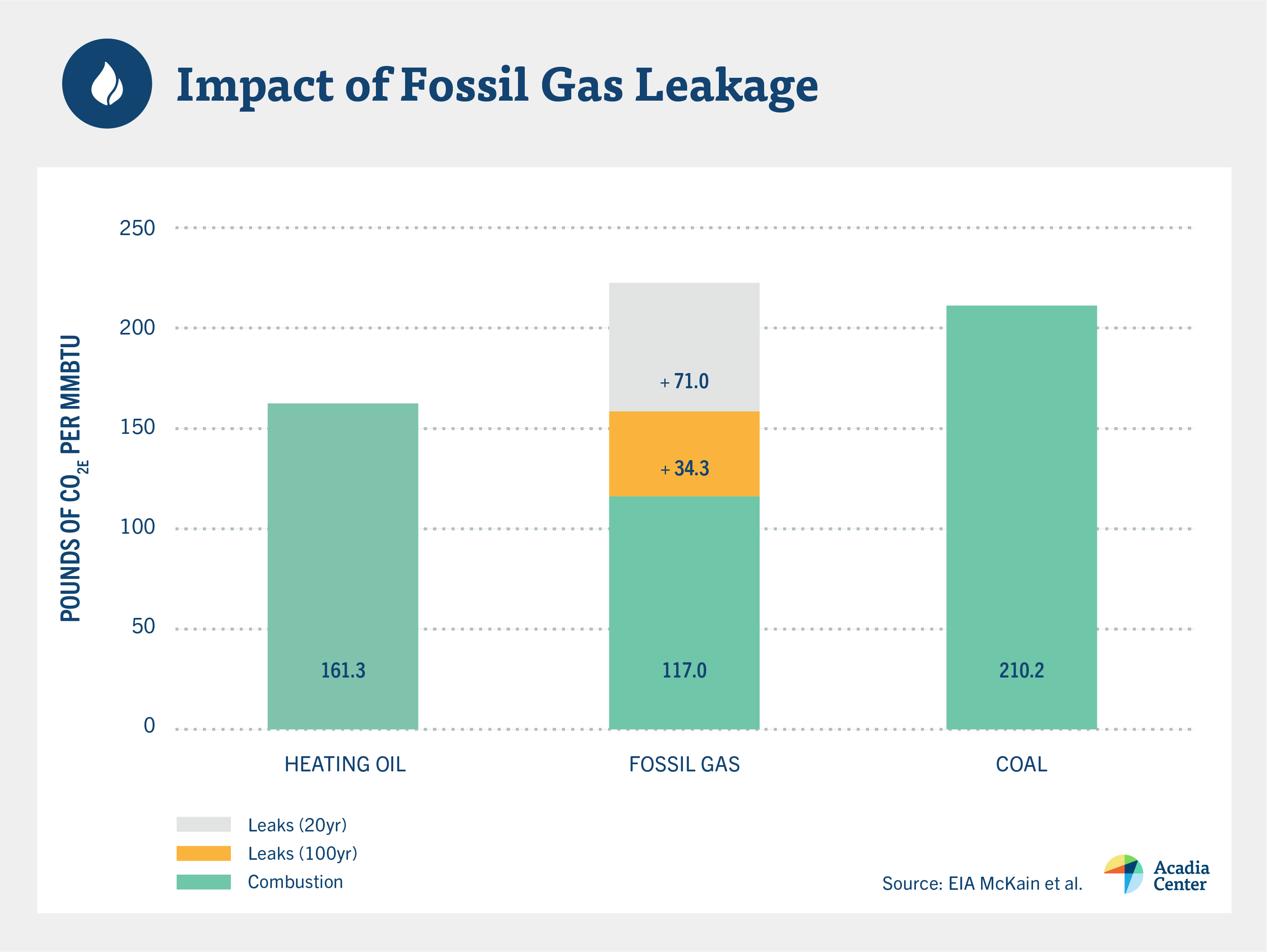
States in the Northeast cannot meet their legislated climate goals if they continue to rely on natural gas. Without significant policy changes, the current carbon dioxide emissions attributable to natural gas alone will far exceed the total carbon allowances for all fossil fuels by 2050, as demonstrated by the chart below. As states continue to accelerate their emissions reduction timelines to reflect the latest climate science, this problem will be further exacerbated, emphasizing the need for bold and immediate gas policy reform.
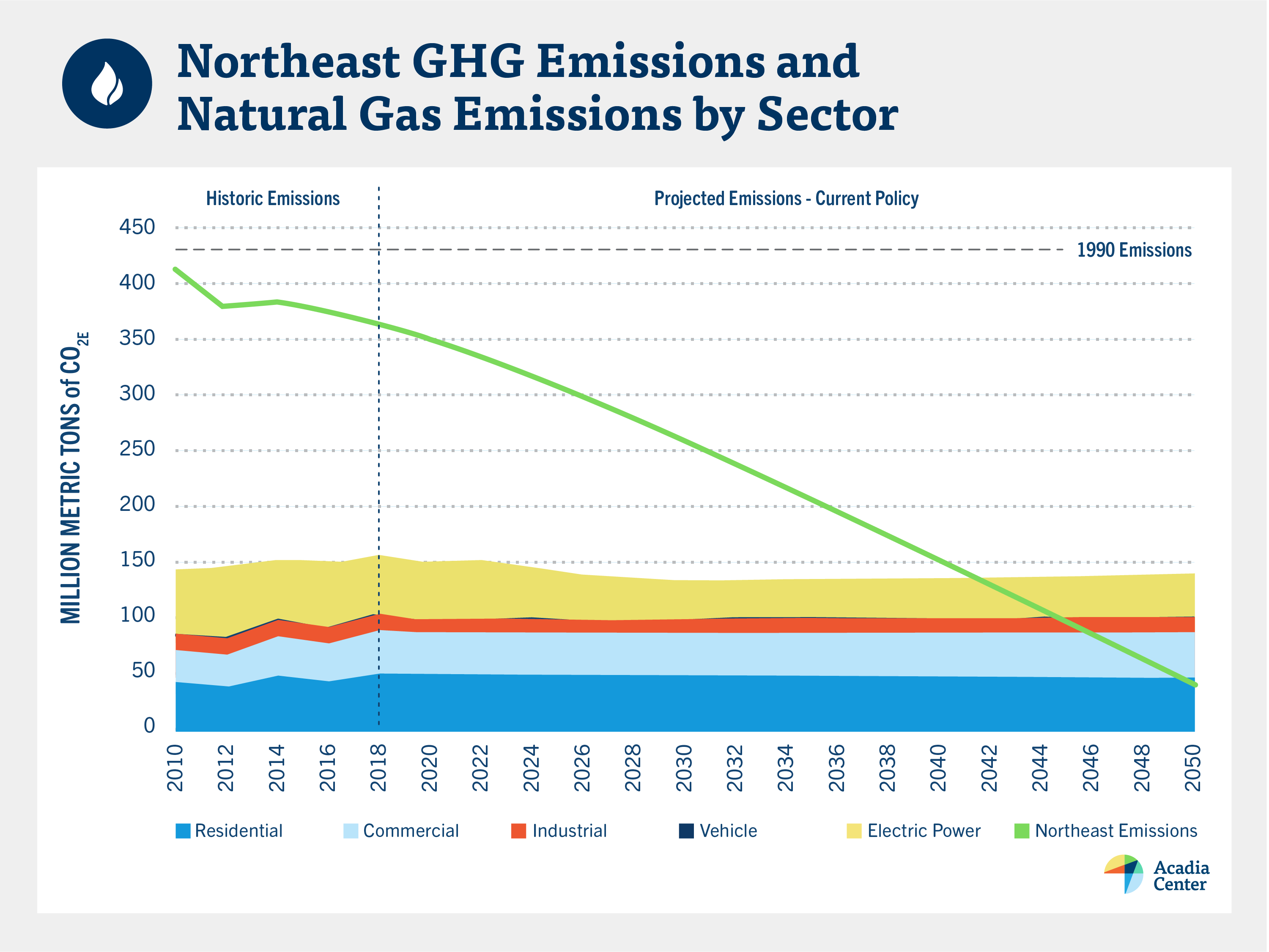
Yet fossil fuel interests in the region continue to advocate for gas expansion at ratepayer expense. Acadia Center meets these fossil fuel interests head-on with both political pressure and science-based analysis that offers an energy future that is cleaner, safer, and empowering for consumers. Acadia Center wages this fight through high-quality analytical publications, testimony in state legislatures, comments in administrative proceedings, presentations to community groups, and media opportunities.
Consumer Interest and Energy Resiliency
Nearly all of the natural gas the Northeast consumes for electricity and heating is extracted from outside our region. However, the Northeast has its own rich sources of renewable energy. By increasing renewable energy sourced from within the region, maximizing energy efficiency investments, and transitioning to electric heating technologies, the Northeast could keep billions more dollars circulating in the local economy and provide local employment.
Additionally, the high demand for gas during winter months (for both electricity and heating), means that consumers pay a premium in energy prices. Relying instead on low-cost, renewable, and reliable energy sources like solar, wind, and hydroelectric power provides energy security superior to imported natural gas. Lastly, it’s important to consider the high complexity and costs of restoring gas service after a damaging event. With climate change causing more extreme weather and natural disasters, a complex grid of fragile pipelines transporting gas over long distances is much less resilient than a grid relying on multiple local sources of renewable electricity.
Health and Safety
Methane, whether derived as a byproduct of oil production, fracking, or from waste sources like landfills and other waste systems, is an explosive fuel. The region’s distribution network of underground pipelines, valves, compressor stations, and storage facilities that delivers this fuel to homes and businesses is aging and poorly maintained. Leaks are common throughout the system and a buildup of gases in any given location could turn deadly in an instant. Human error is a significant concern and was a direct cause of both the Merrimack Valley explosions of 2018, the week-long Aquidneck Island gas outage of 2019, and multitudes of other gas explosions, fires, and evacuations.
These leaks are a public safety, health, and climate danger and leave the Northeast vulnerable to supply disruptions, price shocks, and heating outages. While fixing the most dangerous gas leaks should be an important regional priority, repairs to the entirety of the gas system merely to prolong the gas utility business model will add enormous costs to ratepayers. State regulatory decisions investing ratepayer funds should instead prioritize a transition away from natural gas and towards electrification that will make our communities safer, healthier, and more energy independent.
In addition to widespread methane leakage dangers, natural gas presents an ongoing public health concern even when burned successfully as a heating, cooking, or electricity generation fuel. In homes that use carbon-based fuels like natural gas, the threats of carbon monoxide are ever present and long-term exposure to fumes from gas use from heating and cooking have been linked to significant cases of respiratory and cardiovascular disease.
Equity
Natural gas infrastructure is prevalent in densely populated urban environments and surrounding areas with significant development. In many of the region’s communities on the frontlines of the fight for environmental justice, the exposure to fossil fuel pollution is constant. In addition to polluting the air indoors, gas fumes ventilated to the outside contribute to other air pollution from local gas-fired power generation stations and from vehicle tailpipes. Helping communities transition away from gas will help drastically improve the quality of life and reduce medical expenses.
As the region transitions away from fossil fuel use, and in particular natural gas, it is important to structure utility rates and incentives appropriately to ensure a just transition for all consumers and avoid price shocks. Acadia Center’s experience and presence in docket proceedings around the region are central to a responsible wind down of local gas distribution companies that will serve the public interest.
Energy Efficiency
Overview of Energy Efficiency Programs
Benefits Provided by State Energy Efficiency Programs 2012-2023
Each state in the Northeast operates and administers state energy efficiency programs that leverage surcharges on customer electricity and natural gas bills, combined with other funding sources, to deliver energy efficiency and electrification improvements to customers, from households and businesses to municipalities. While these programs have been operating for different lengths of time depending on the state, most programs in the Northeast commenced operation in the late 1990s or early 2000s. Based on data made available by each of the state-level programs, the below infographics succinctly summarize the benefits energy efficiency programs have delivered over the 2012-2023 time period, both at an individual state level and more broadly at an aggregated regional level.
As the first infographic below highlights, collectively since 2012, these programs have delivered over $55 billion in total lifetime benefits to households and businesses across the region, providing over $3.40 in benefits per every $1.00 invested in the programs. Simultaneously, the programs play an instrumental role in creating and sustaining over 160,000 energy efficiency industry jobs in the region and have reduced lifetime CO2 emissions at levels equivalent to removing nearly 33 million gasoline-powered cars from the road for one year. Additionally, the programs have generated significant health benefits associated with a reduction in fossil fuel combustion, improved occupancy comfort, and reduced stress on and improved reliability of the regional electric grid.
See New England below or jump to these states:
Connecticut Maine Massachusetts New Hampshire
New England
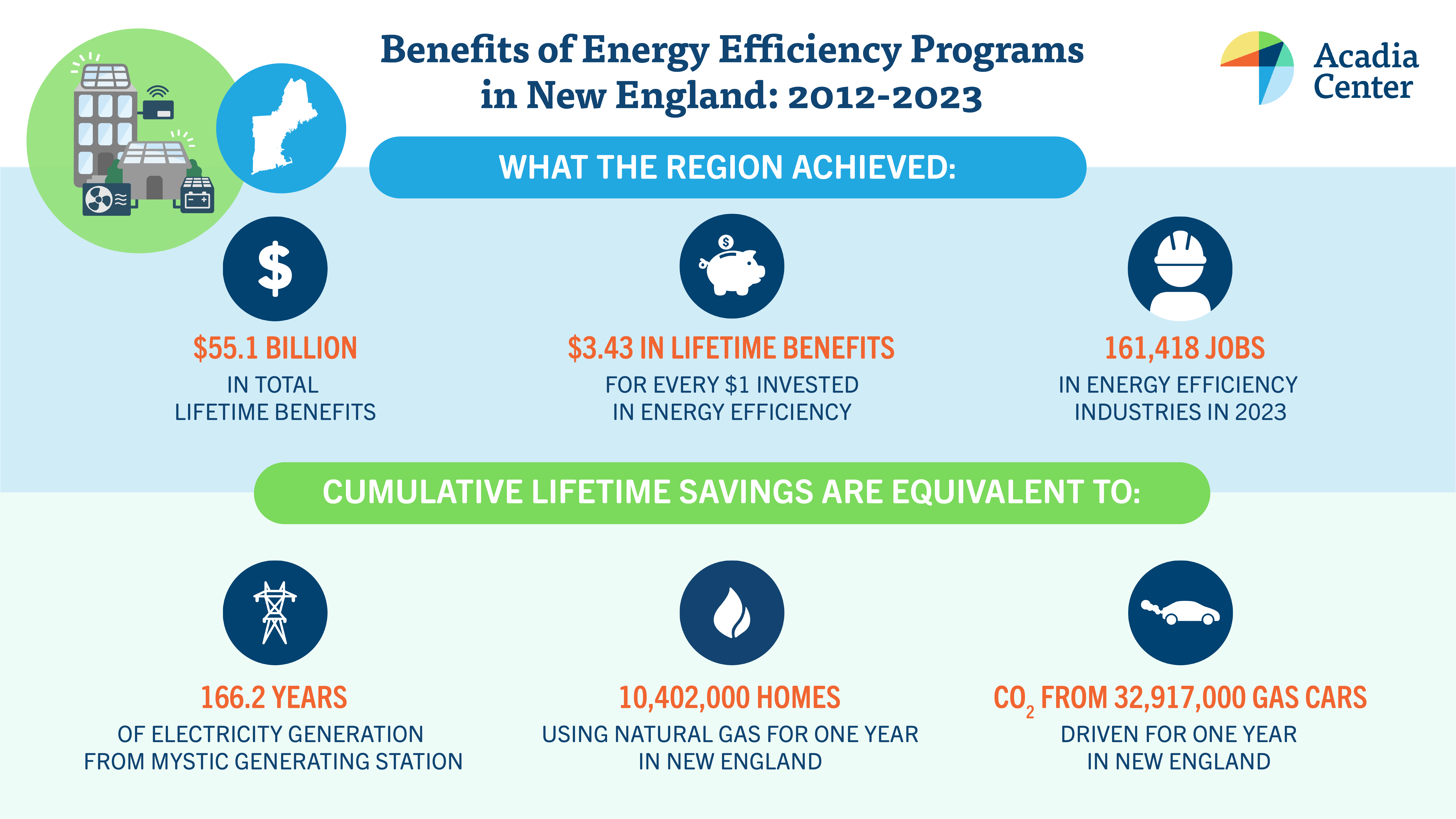
The regional infographic above and state infographics below not only highlight the progress made to date but also serve to highlight the critical role that energy efficiency and electrification programs will need to play in the coming decades to achieve the climate goals of the region while simultaneously delivering cost savings to consumers and improving overall quality of life in the region. Acadia Center is proud to have been a key advocate and catalyst over the past decade for the policies that have boosted energy efficiency. Acadia Center firmly believes that the progress described below, while substantial, represents only a fraction of the full technical and economic potential for energy efficiency in the region, especially when considering its potential as a competitive resource to provide services to and reduce costs for the region’s electricity grid.
The data presented in the infographics is based on data provided by individual state energy efficiency programs. The specific methodologies used to calculate lifetime energy savings, greenhouse gas (GHG) emissions avoided, program costs, and program benefits vary across states and can sometimes make cross-state comparisons challenging at times. Acadia Center presents the data based on what was provided by state agencies with no modifications or edits to state-specific methodologies.
New England Data & Methodology Notes: Historic data from various state-level reports and websites was collected, compiled, and aggregated at the regional level by Acadia Center. Please see notes below individual state infographics for details on state-level data sources used. The infographic also leverages data from several other sources, including:
– Average Natural Gas Consumption Per Home: U.S. Energy Information Administration’s (EIA’s) Residential Energy Consumption Survey (RECS) 2020 data. Total count of homes in infographic above represents the sum of individual state totals as presented in infographics below.
– Mystic Generating Station Annual Generation: EIA’s Form EIA-923 2019-2022 data on average annual generation. Assumes 1,719 GWh of average annual generation.
– Average Passenger Vehicle Emissions: U.S. Environmental Protection Agency’s (EPA’s) “Tailpipe Greenhouse Gas Emissions from a Typical Passenger Vehicle” data. Assumes 4.6 metric tons of CO2 per year per typical passenger vehicle.
– Energy Efficiency Industry Jobs: U.S. Department of Energy’s (DOE’s) Energy Employment By State 2024 report.
Connecticut
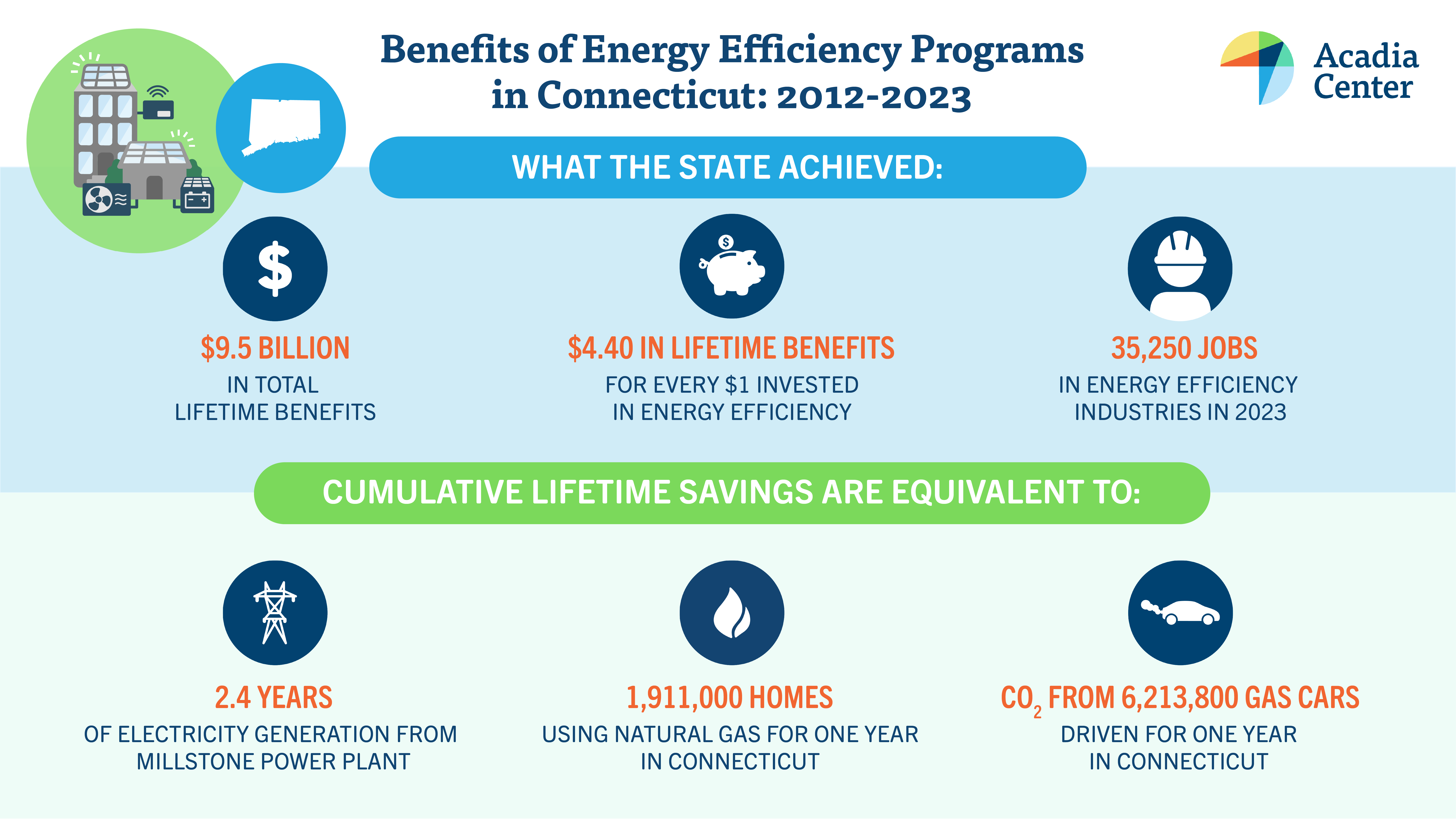
Connecticut Data & Methodology Notes: Historic data from the Connecticut Energy Efficiency Dashboard and Connecticut Energy Efficiency Board Annual Legislative Reports was collected and compiled by Acadia Center. The infographic also leverages data from several other sources, including:
– Average Natural Gas Consumption Per Home: Energy Information Administration’s (EIA’s) Residential Energy Consumption Survey (RECS) 2020 data. Assumes for homes that use natural gas in Connecticut, average household annual gas consumption is 56.2 MMBtu.
– Millstone Power Stations Annual Generation: EIA’s Form EIA-923 2022 data on annual generation. Assumes 16,464 GWh of generation in 2022.
– Average Passenger Vehicle Emissions: Environmental Protection Agency’s (EPA’s) “Tailpipe Greenhouse Gas Emissions from a Typical Passenger Vehicle” data. Assumes 4.6 metric tons of CO2 per year per typical passenger vehicle.
– Energy Efficiency Industry Jobs: Department of Energy’s (DOE’s) Energy Employment By State 2024 report.
Maine
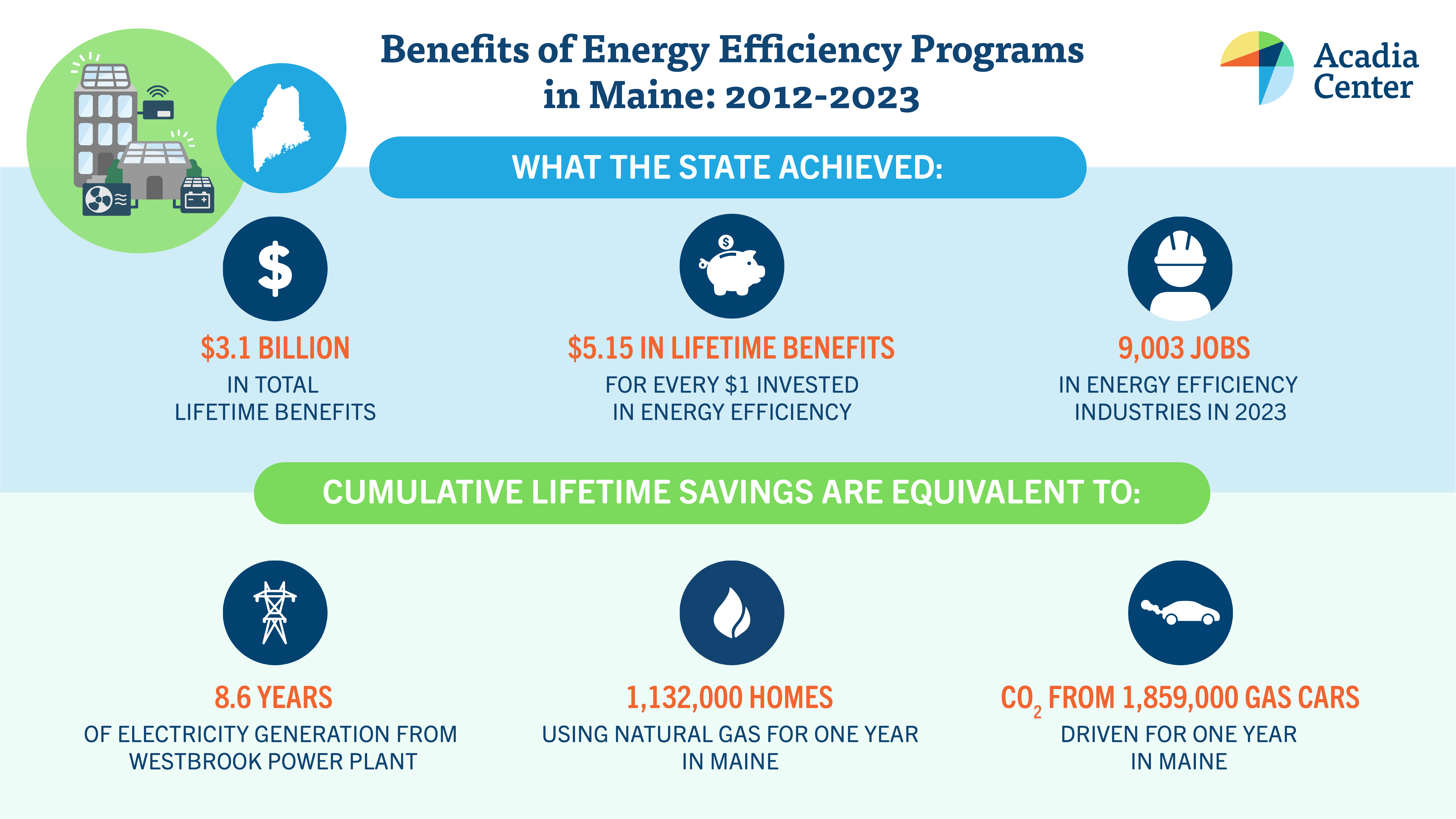
Maine Data & Methodology Notes: Historic data from the Efficiency Maine Annual Reports was collected and compiled by Acadia Center. The infographic leverages data from several other sources, including:
– Average Natural Gas Consumption Per Home: Energy Information Administration’s (EIA’s) Residential Energy Consumption Survey (RECS) 2020 data. Assumes for homes that use natural gas in Maine, average household annual gas consumption is 50.8 MMBtu.
– Westbrook Energy Center Annual Generation: EIA’s Form EIA-923 2022 data on annual generation. Assumes 2,462 GWh of generation in 2022.
– Average Passenger Vehicle Emissions: Environmental Protection Agency’s (EPA’s) “Tailpipe Greenhouse Gas Emissions from a Typical Passenger Vehicle” data. Assumes 4.6 metric tons of CO2 per year per typical passenger vehicle.
– Energy Efficiency Industry Jobs: Department of Energy’s (DOE’s) Energy Employment By State 2024 report.
Massachusetts
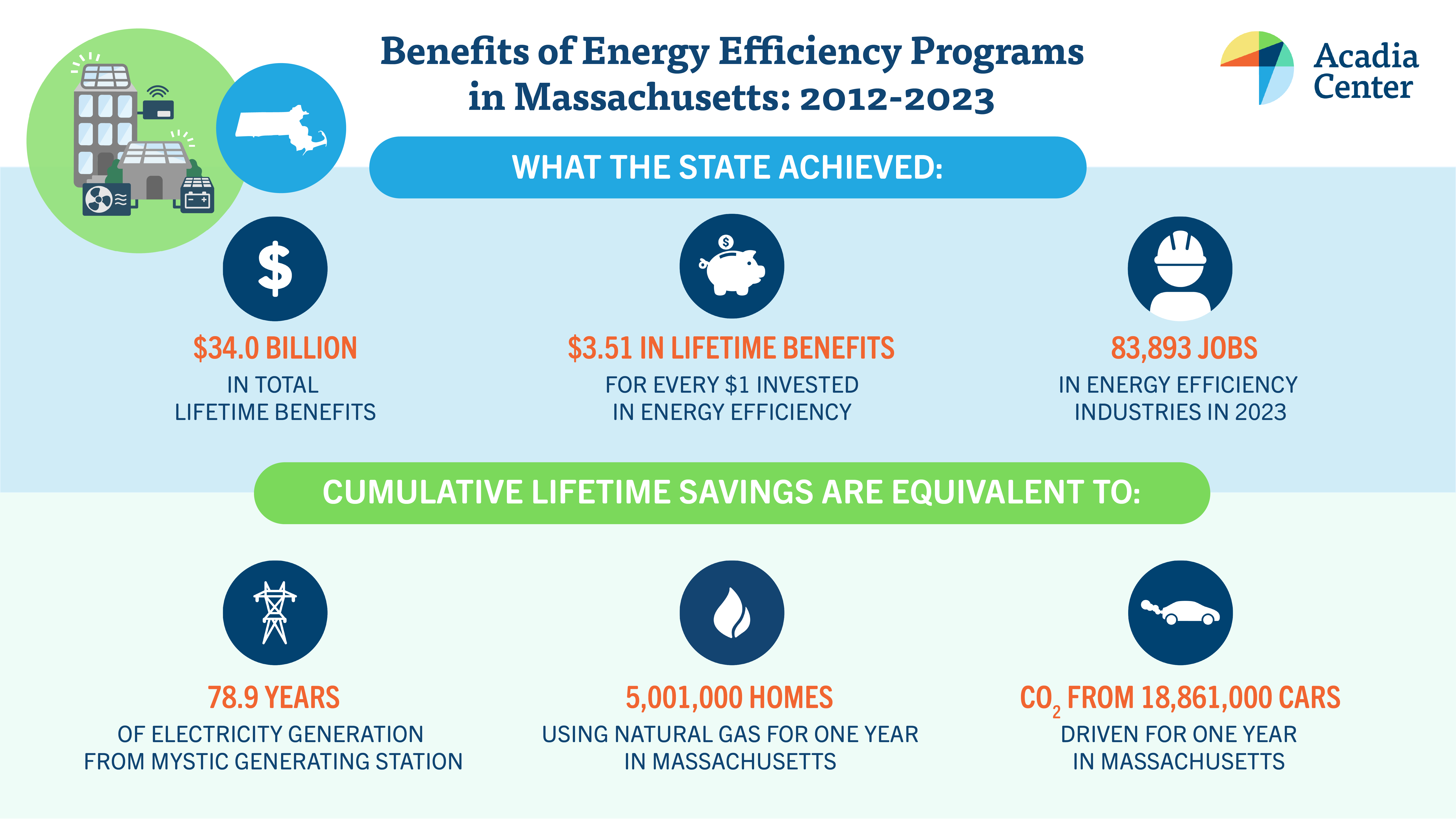
Massachusetts Data & Methodology Notes: Historic data from the Massachusetts Energy Efficiency Database (“Mass Save Data”) was collected and compiled by Acadia Center. This included data from both the “Performance Details” site and “GHG” site found on Mass Save Data. The infographic leverages data from several other sources, including:
– Average Natural Gas Consumption Per Home: Energy Information Administration’s (EIA’s) Residential Energy Consumption Survey (RECS) 2020 data. Assumes for homes that use natural gas in Massachusetts, average household annual gas consumption is 60.7 MMBtu.
– Mystic Generating Station Annual Generation: EIA’s Form EIA-923 2019-2022 data on average annual generation. Assumes 1,719 GWh of average annual generation.
– Average Passenger Vehicle Emissions: Environmental Protection Agency’s (EPA’s) “Tailpipe Greenhouse Gas Emissions from a Typical Passenger Vehicle” data. Assumes 4.6 metric tons of CO2 per year per typical passenger vehicle.
– Energy Efficiency Industry Jobs: Department of Energy’s (DOE’s) Energy Employment By State 2024 report
New Hampshire
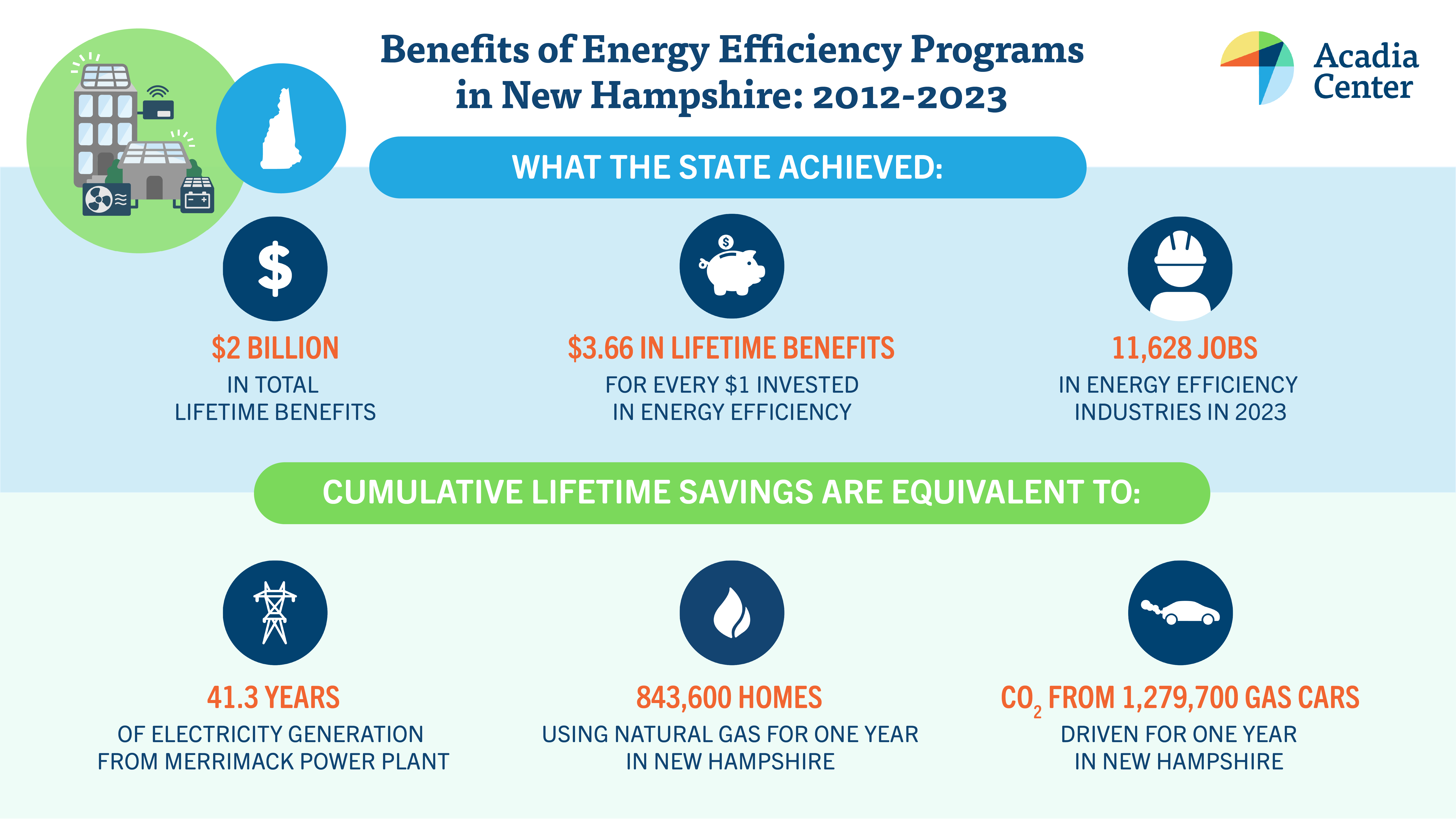
New Hampshire Data & Methodology Notes: Historic data from various sources, depending on year, was collected and compiled by Acadia Center. Data for 2012-2017 is from New Hampshire Statewide Energy Efficiency Plans (2017 example), 2018-2020 data is from NHSaves: Program Highlights 2018-2020, and 2021-2023 data is from NHSaves Impact Reports (2022 example). Prior to 2020, data on total lifetime benefits ($) was not provided by the program. To estimate total lifetime benefits associated with measures installed prior to 2020, Acadia Center calculated a total benefits ($) per lifetime combined electric and fuels savings (MMBtu) ratio of $21.1 and applied this ratio to measures installed prior to 2020.
– Average Natural Gas Consumption Per Home: Energy Information Administration’s (EIA’s) Residential Energy Consumption Survey (RECS) 2020 data. Assumes for homes that use natural gas in New Hampshire, average household annual gas consumption is 56.0 MMBtu.
– Merrimack Station Annual Generation: EIA’s Form EIA-923 2022 data on annual generation. 308.8 GWh of generation in 2022.
– Average Passenger Vehicle Emissions: Environmental Protection Agency’s (EPA’s) “Tailpipe Greenhouse Gas Emissions from a Typical Passenger Vehicle” data. Assumes 4.6 metric tons of CO2 per year per typical passenger vehicle.
– Energy Efficiency Industry Jobs: Department of Energy’s (DOE’s) Energy Employment By State 2024 report.
Rhode Island

Rhode Island Data & Methodology Notes: Historic data from the Rhode Island Energy Efficiency Year-End Reports (2023 Example) was collected and compiled by Acadia Center. The infographic leverages data from several other sources, including:
– Average Natural Gas Consumption Per Home: Energy Information Administration’s (EIA’s) Residential Energy Consumption Survey (RECS) 2020 data. Assumes for homes that use natural gas in Rhode Island, average household annual gas consumption is 77.0 MMBtu.
– Manchester Street Generating Station Annual Generation: EIA’s Form EIA-923 2022 data on annual generation. Assumes 991.1 GWh of generation in 2022.
– Average Passenger Vehicle Emissions:S. Environmental Protection Agency’s (EPA’s) “Tailpipe Greenhouse Gas Emissions from a Typical Passenger Vehicle” data. Assumes 4.6 metric tons of CO2 per year per typical passenger vehicle.
– Energy Efficiency Industry Jobs: Department of Energy’s (DOE’s) Energy Employment By State 2024 report.
Vermont

Vermont Data & Methodology Notes: Historic data from the Efficiency Vermont Annual Reports was collected and compiled by Acadia Center. The infographic leverages data from several other sources, including:
– Average Natural Gas Consumption Per Home: Energy Information Administration’s (EIA’s) Residential Energy Consumption Survey (RECS) 2020 data. Assumes for homes that use natural gas in Vermont, average household annual gas consumption is 58.5 MMBtu.
– McNeil Generating Station Annual Generation: EIA’s Form EIA-923 2022 data on annual generation. Assumes 229.0 GWh of generation in 2022.
– Average Passenger Vehicle Emissions: Environmental Protection Agency’s (EPA’s) “Tailpipe Greenhouse Gas Emissions from a Typical Passenger Vehicle” data. Assumes 4.6 metric tons of CO2 per year per typical passenger vehicle.
– Energy Efficiency Industry Jobs: Department of Energy’s (DOE’s) Energy Employment By State 2024 report.
Building Electrification
Acadia Center’s Building Electrification Program couples regional coalition-building with reliable modeling and analysis to create momentum for innovative policies to make every building a zero-emissions building.
Buildings are the second-largest source of greenhouse gas emissions in the Northeast. In order to reach our climate goals, 12.7 million housing units and more than 4 billion square feet of commercial real estate must be completely electrified in the next two decades or sooner. The barriers are more logistical than technical: there are millions of individual decision-makers to coordinate, long equipment lifetimes and idiosyncratic building stock to account for, and safety hazards like asbestos to remediate. Acadia Center’s policy analysis and building energy modeling help to sort through these barriers and arrive at innovative policy proposals that will eliminate emissions from buildings.
Energy Efficiency
Energy efficiency has been, and will continue to be, the lowest cost greenhouse gas mitigation strategy for the Northeast—and every other region. Read more about Acadia Center’s history as a leading energy efficiency advocate and its plans for the next generation of energy efficiency here.
About Building Electrification
To eliminate emissions from buildings, all of the equipment that currently burns fossil fuels in our homes and businesses must be replaced with an efficient, electric alternative. Modern electric equipment like heat pumps and induction stoves have the potential to be straightforwardly, verifiably, fully zero-emissions when powered by the sun or the wind. But even with the current electric grid, heat pumps can reduce emissions by about 60% or more compared to the cleanest fossil fuel system.
 Heat pumps reduce emissions so substantially because they are super-efficient: rather than generating heat, they move it from one place to another. Taking advantage of the tendency of warm air to move to cold areas, a heat pump uses a refrigerant to gather heat from the outside air or the ground and deposit it within a living space. By contrast, a furnace or boiler works by burning a fossil fuel to heat a medium—water or metal—which is then used to heat the living space. That extra step is costly: while heat pumps have an average annual efficiency of nearly 300%, most boilers and furnaces sold today are 85% to 90% efficient.
Heat pumps reduce emissions so substantially because they are super-efficient: rather than generating heat, they move it from one place to another. Taking advantage of the tendency of warm air to move to cold areas, a heat pump uses a refrigerant to gather heat from the outside air or the ground and deposit it within a living space. By contrast, a furnace or boiler works by burning a fossil fuel to heat a medium—water or metal—which is then used to heat the living space. That extra step is costly: while heat pumps have an average annual efficiency of nearly 300%, most boilers and furnaces sold today are 85% to 90% efficient.
Heat pumps might sound like a strange new technology, but most people in the Northeast already own one: central and window air conditioners use the same process, but in reverse. Indeed, many of the cold climate heat pumps which will heat our buildings in the future even look similar to a central air conditioner. Heat pump technology can provide a building with space heating, air conditioning, and water heating—the three end uses that account for the lion’s share of energy use and emissions in most buildings.
Induction cooking appliances round out the clean, all-electric building of the future. While this equipment is super-efficient—it can boil a quart of water in ninety seconds—its most important feature is that it provides a superior cooking experience with none of the dangerous fumes that gas stoves generate. One of these fumes—nitrogen dioxide—has even been linked to the development of asthma in children. Induction stoves are yet another example of the many health benefits of electrification in buildings.
Policy & Coalitions
Heat pumps are commercially available, prevalent in other parts of the world, and a crucial part of achieving state climate goals. Despite that, public awareness of the technology is limited in the Northeast. As a result, meaningful state policies remain sparse. Acadia Center’s clean heating work is focused on working with policymakers, advocates, and the public to spread awareness about the benefits of this technology.
Working for justice. Building electrification is desirable not just for its potential to reduce emissions, but because it means cleaner indoor air, less heat stress illness, and a significant reduction in energy bills for many homes. Specifically, electrification can eliminate some of the negative impacts that fossil fuels have on low-income households, people of color, and English-isolated families. These communities bear the brunt of fossil fuels’ health and safety impacts. Acadia Center’s advocacy focuses on the need to invest materially in the buildings in which these communities live and work, reducing these threats to their well-being.
Spreading awareness. Heat pump equipment can save money, increase comfort, improve health and safety, and reduce emissions. Yet because cold-climate heat pump models are relatively new to the Northeast, the benefits of the technology are not well understood. Acadia Center’s informative reports—like Clean Heating Pathways—use plain language and clear data to demonstrate that clean heating will improve people’s lives in concrete ways.
Energetic advocacy. State policies that offer financial assistance for electrification measures, set statewide electrification targets, ensure that every state resident can benefit from electrification regardless of income, and provide support for the contractor community are critical for expanding the marketplace for clean heating equipment. Acadia Center uses its role on energy efficiency advisory councils and works in coalition with its partners to make the case for ambitious and innovative policy approaches that will lead to widespread adoption of heat pumps across the region.
Policy development. Acadia Center brings deep subject matter expertise about building science and HVAC technology to state climate policy discussions. Working with stakeholder bodies, agency decision-makers, trade associations, and a variety of other industry actors, Acadia Center brings its research to bear in the regulatory arena, ensuring that state policies and regulations reflect sound science and respond effectively to the needs of state residents.
PowerHouse
Acadia Center’s advocacy for building electrification spans the Northeast. And because weather, fuel prices, cost of living, and building stock characteristics vary widely from place to place, research and analysis must be closely calibrated to local conditions to provide policymakers with the most relevant possible information.
The PowerHouse home energy model provides this hyper-local analysis. Leveraging trusted data sources, the model generates a detailed assessment of the energy, emissions, and bill impacts of whole-home electrification on an hourly basis. Power House can answer a variety of questions significant to policymakers, including:
- How much money will electrification save for building occupants relative to fossil fuel business-as-usual?
- How much greenhouse gas emissions can electrification reduce?
- Precisely how will the growth of solar and wind on the electric grid impact the emissions impacts of electrification?
- What will the winter peak impacts of building electrification be, and what are the best ways to manage them?
- How much do heat pumps cost to install, and how will capital costs change with supportive policies?
Building electrification represents one of the great steps forward that states in the Northeast must make to meet climate commitments. Armed with analytical, regulatory, legal, and policy expertise, Acadia Center staff are working to transform the built environment for a zero-carbon economy.
Core Actions
Acadia Center’s research and advocacy is helping to advance policies such as:
- Better consumer incentives for home and business owners who choose to electrify
- All-electric building codes that avoid locking in fossil fuel heating in new buildings
- Workforce development programs that support contractors who install heat pump technologies
- Pairing weatherization and electrification measures to maximize health and emissions benefits
- Flexible electric rate designs that allow building occupants to capture bill savings with their heat pump
Transportation
Overview
States in the Northeast have acknowledged the urgency of the climate crisis, established nation-leading emissions reduction targets for 2030, and made great progress in reducing pollution from the electric sector. Unfortunately, transportation emissions in the Northeast and Mid-Atlantic region have remained stubbornly high—now accounting for 43% of total CO2 emissions—and time is running out to establish the policies necessary to achieve the region’s 2030 targets.
Beyond the urgent need for action to address climate change, our outdated and underfunded transportation system hinders economic opportunity and has devastating public health impacts. Worst of all, those economic barriers and public health costs overwhelmingly affect our most marginalized populations: low-income communities, communities of color, and the rural communities lacking mobility options. After a century of transportation decisions that have exacerbated inequalities, leading to cities segregated by highways and the emergence of transit deserts, it is well past time for investment in a just and sustainable transportation future.
Acadia Center is working to advance a suite of policies across the region that will deliver cleaner, more accessible, and more affordable transportation options that will help all of our communities thrive.
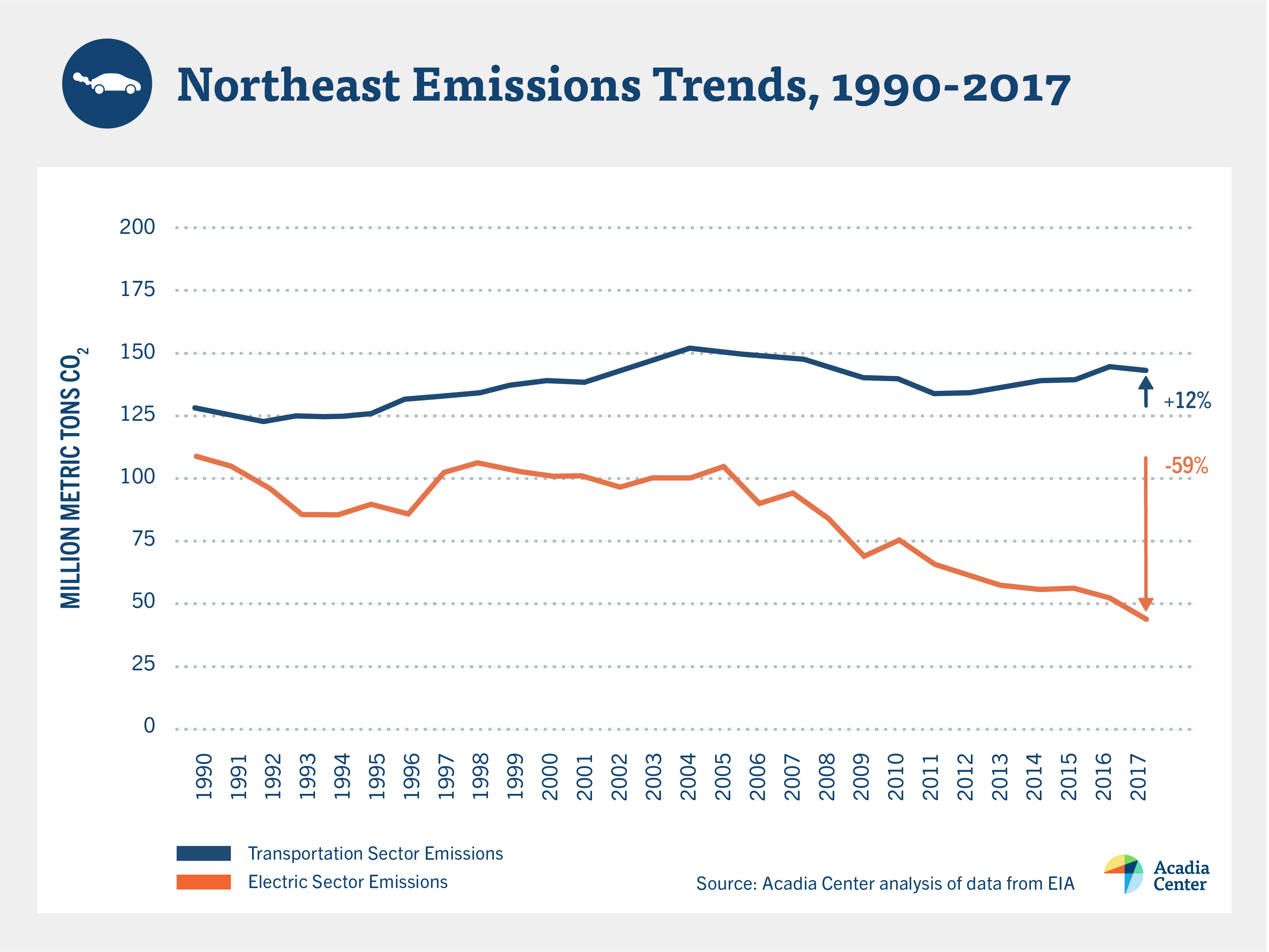
Priority Areas
Supporting Multi-Modal Mobility
Transportation investments made to-date have largely prioritized infrastructure for cars at the expense of our communities and environment. Shifting resources from car lanes and parking lots to public transit, sidewalks, bike lanes and green spaces will improve mobility options, reduce air pollution, and create more connected communities.
Accessible, affordable, and reliable public transit serves as the connective tissue for sustainable, equitable communities. Compared to personal vehicles, efficient public transit systems move more people more quickly, reduce transportation costs, alleviate traffic, produce less pollution, and allow communities to reclaim paved roadways for things people care about, like parks, restaurant patios, and bike paths. Unfortunately, public transit systems across the region are underfunded, leaving many riders with infrequent, unreliable service while many others have no access to transit at all. That lack of sufficient transit presents a major barrier between underserved communities and jobs, healthcare services, and other basic needs, exacerbating economic and health disparities. Increased public transit funding and fare-free transit can help deliver a more equitable, sustainable future.
Active transportation—primarily walking and biking—offers pollution-free mobility and substantial health benefits, but the lack of safe and connected sidewalks and bike lanes can be a major deterrent. Rather than continuing the history of car-centric investment, we should be investing in infrastructure to support active mobility and complete streets, ensuring that everyone can get around safely and efficiently whether they are walking, biking, on the bus or in a car.
 Advancing the Transition to Electric Vehicles
Advancing the Transition to Electric Vehicles
The vast majority of transportation pollution comes from vehicle tailpipes, with cars, trucks, and buses accounting for 82% of the transportation sector’s CO2 emissions. In order to meaningfully and urgently address the transportation sector’s contributions to climate change and poor air quality, a rapid transition from polluting vehicles to non-emitting electric vehicles (EVs) is necessary. Vehicles powered by electricity produce far less pollution than those running on gasoline or diesel, and as the electric grid gets cleaner, the benefits of electrification will grow. Acadia Center is working across a variety of forums to advance transportation electrification policies that are ambitious, equitable, and good for consumers.
Acadia Center uses our seats on key decision-making bodies to advocate for policies that will help consumers, companies, and public fleets transition to EVs. Through forums including the Massachusetts Zero Emission Vehicle Commission and the Connecticut CHEAPR Board, Acadia Center has worked to establish and increase rebates for EVs to help address cost barriers, while also calling for the expansion of rebate programs to include used vehicles, electric bikes, and other measures designed to expand access to electric mobility options, particularly for low- and moderate-income consumers.
Beyond vehicle incentives, Acadia Center supports electric vehicle targets and requirements as another means of shifting the market towards clean vehicles. Through the Multi-State ZEV Task Force and the recent Multi-State Medium- and Heavy-Duty ZEV agreement, states are working together to ensure that auto manufacturers and major vehicle purchasers are active participants in the transition to an electrified future. Across all of these efforts, Acadia Center advocates for the prioritized deployment of clean vehicles—like electric buses and delivery vehicles—in communities facing the worst impacts from transportation pollution.
Acadia Center also applies its expertise in electric utility rates and grid modernization in the vehicle electrification arena. Changes to electric utility rate structures can ensure that charging EVs—whether at home, at work, in town or on the highway—is good for consumers, the electric grid and the environment. For example, through time-of-use (TOU) rates utilities can offer customers electricity at lower costs when demand for electricity is low. By incentivizing EV charging when demand for electricity is low, we can ensure that EV owners save money, the grid is more balanced, and we all benefit from cleaner air and lower electricity costs because there is less need to run the oldest, dirtiest, most expensive power plants.
Carbon Markets
Carbon Markets
Acadia Center works with partners across the region to establish and strengthen programs that reduce pollution and invest in a clean energy future. Acadia Center’s Carbon Markets Program focuses on policies that hold polluters financially accountable for carbon dioxide (CO2) emissions and generate funding for programs and projects that reduce harmful pollution, create jobs, and deliver a better quality of life in every community. Our advocacy on carbon programs is focused on three opportunities:
- Strengthening the Regional Greenhouse Gas Initiative (RGGI) to reduce pollution from power plants and make investments in clean energy and energy efficiency.
- Launching an ambitious, equitable program through the Transportation and Climate Initiative (TCI) to reduce pollution from vehicles and fund transportation investments that will give more people access to clean, affordable mobility options.
- Passing legislation to establish an economy-wide price on carbon, accelerating our transition to a clean energy future.
Why Carbon Programs?
Currently, the price of fossil fuels is not grounded in the reality of their health impacts: the price neither reflects the current impacts of local air pollution, nor the devastating effects of current and future climate change. To transition our economy as quickly as possible away from fossil fuels and to level the playing field for clean alternatives, we need to begin by making the price reflect the “true cost” of fossil fuel use. Charging for CO2 and other greenhouse gas emissions helps hold polluters accountable and ensures that the price of fossil-fuel fired power reflects some of the costs imposed on society (sometimes referred to as the “social cost of carbon”). With a more accurate price on greenhouse gas-spewing activities, the markets we already rely on will deliver better, cleaner options. Putting a price on carbon allows individual firms to find their own creative solutions to reducing emissions and could achieve emissions cuts more quickly, cheaply, and efficiently than with regulation alone.
These carbon pricing policies take the form of either cap-and-invest programs or flat fees (often referred to as “carbon taxes”) applied to greenhouse gas emissions. Acadia Center’s work has been instrumental in establishing and strengthening the Regional Greenhouse Gas Initiative (RGGI), the first regional cap-and-invest program in the nation, and Acadia Center is currently working to ensure that the region improves on that model in the transportation sector through the Transportation and Climate Initiative (TCI). Cap-and-invest programs set a declining limit (“cap”) on emissions, hold auctions through which polluters can buy emissions allowances, and use the proceeds from those auctions to invest in projects that achieve strategic decarbonization goals. Both the price of allowances and the investment of allowance proceeds help to reduce pollution.
Guiding Considerations for Acadia Center’s Carbon Markets Program
Acadia Center’s work to put a price on greenhouse gas emissions focuses on two key considerations:
- Cap-and-invest programs alone are insufficient; additional, complementary policies are necessary at the federal, state, and local level to deliver CO2 reductions with the urgency required to address the climate crisis. For example, robust energy efficiency programs are critical for cutting pollution in the electric sector while helping consumers save on their energy bills. In the transportation sector, sufficiently funded public transit (made affordable for all riders) is a critical complementary measure to TCI. Both examples above are necessary under any circumstances, but cap-and-invest programs can provide an important source of funding to help make them possible.
- Market-based solutions have the potential to exacerbate environmental and social injustices if they are not designed with equity as a top priority and meaningful input from frontline communities. While economists favor carbon pricing for its ability to deliver CO2 reductions at the lowest possible cost, relying on price signals alone does not ensure that emission reductions will occur in the communities most in need of cleaner air. People living in low-income communities and communities of color which bear the brunt of environmental injustices are rightfully concerned that a continued reliance on market forces will maintain the inequitable factors that have left them breathing dirtier air. Acadia Center is committed in its advocacy on market-based policies to ensuring that these concerns are heard and addressed with solutions that deliver cleaner air in communities overburdened by pollution and greater investment in underserved communities.
The Regional Greenhouse Gas Initiative: Reducing Power Plant Pollution and Investing in the Clean Energy Future
The Regional Greenhouse Gas Initiative (RGGI, pronounced “Reggie”) is a cap-and-invest program that was launched as a first-in-the-nation program designed to reduce CO2 emissions from power plants. Since RGGI’s launch the participating states have experienced substantial benefits and demonstrated that climate action can be a boon for the economy. The states and stakeholders have also learned valuable lessons through the RGGI experience, both in terms of what has worked and what must be improved on to deliver a truly ambitious and equitable program.
As detailed in Acadia Center’s RGGI: 10 Years in Review Report, since 2008, the RGGI program has helped participating states outperform the rest of the country:
- CO2 emissions from RGGI power plants have fallen by 47%, outpacing the rest of the country by 90%;
- Electricity prices in RGGI states have fallen by 5.7%, while prices have increased in the rest of the country by 8.6%;
- GDP of the RGGI states has grown by 47%, outpacing growth in rest of the country by 31%;
- RGGI states have generated $3.2 billion in allowance auction proceeds, the majority of which have been invested in energy efficiency and renewable energy programs; and
- RGGI-driven reductions in co-pollutant emissions have resulted in over $5.7 billion in health and productivity benefits.
While RGGI has been a proven success at the regional level, Acadia Center is working hard to make it stronger and to ensure that the program delivers benefits in overburdened and underserved communities. Through the 2021 RGGI Program Review, Acadia Center and our allies will be advocating for key improvements—including a more ambitious emissions cap—to help participating states cut power plant pollution faster. Acadia Center will also be working at the state and regional level to include protections for communities suffering from disproportionate pollution, to guarantee a larger share of RGGI proceeds reach underserved communities, and to ensure that RGGI-funded programs are designed to meet the needs of all residents. For example, Acadia Center uses its seat on state energy efficiency councils to deliver next-generation energy efficiency programs that will give low-income consumers and renters greater access to RGGI-supported energy savings.
The Transportation and Climate Initiative: Reducing Vehicle Pollution and Investing in Clean, Modern, Equitable Transportation Options
The Transportation and Climate Initiative (TCI) has the potential to deliver substantial pollution reductions while generating funds for clean transportation investments. Through this initiative, twelve Northeast and Mid-Atlantic states and Washington, D.C. have been working together to develop a regional program that will place a declining limit on carbon emissions from transportation while delivering a new funding source to help advance a more modern, equitable, low-carbon transportation future. Acadia Center is leading efforts at the local and regional level to ensure that TCI lives up to its potential by crafting a program that is both ambitious on climate and designed to prioritize benefits in communities that lack access to transportation options and suffer from transportation pollution.
Acadia Center takes a collaborative approach to TCI advocacy, working closely with partners to lead state-focused TCI forums and at the regional level through Our Transportation Future. Acadia Center’s TCI analysis helps to inform stakeholders and policymakers on the opportunities presented through TCI, namely improving air quality, addressing climate change, and supporting a range of clean transportation investments to help every community thrive.
Carbon Pricing Legislation
Working through coalitions in states across the region, Acadia Center has been working to pass first-in-the-nation carbon pricing legislation. Acadia Center supports bills like An Act to Promote Green Infrastructure and Reduce Carbon Emissions in Massachusetts, which would establish a price on carbon across the economy, invest in clean energy through a Green Infrastructure Fund that Acadia Center helped design, and provide income-based rebates to ensure progressive impacts.



















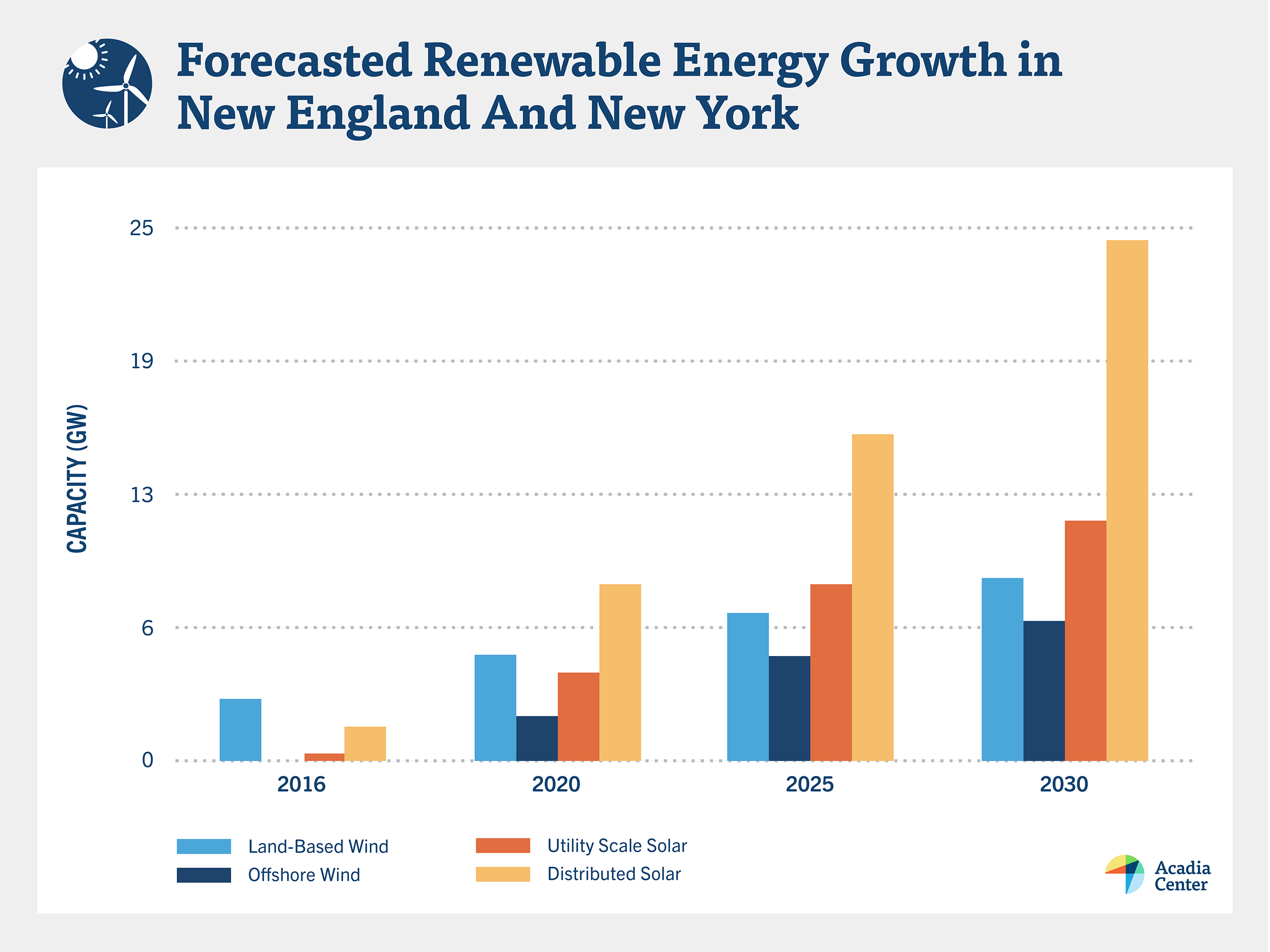

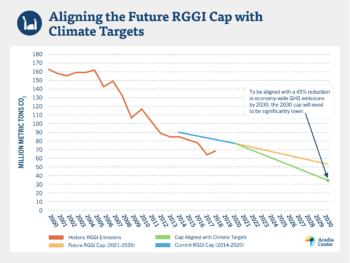
Follow us